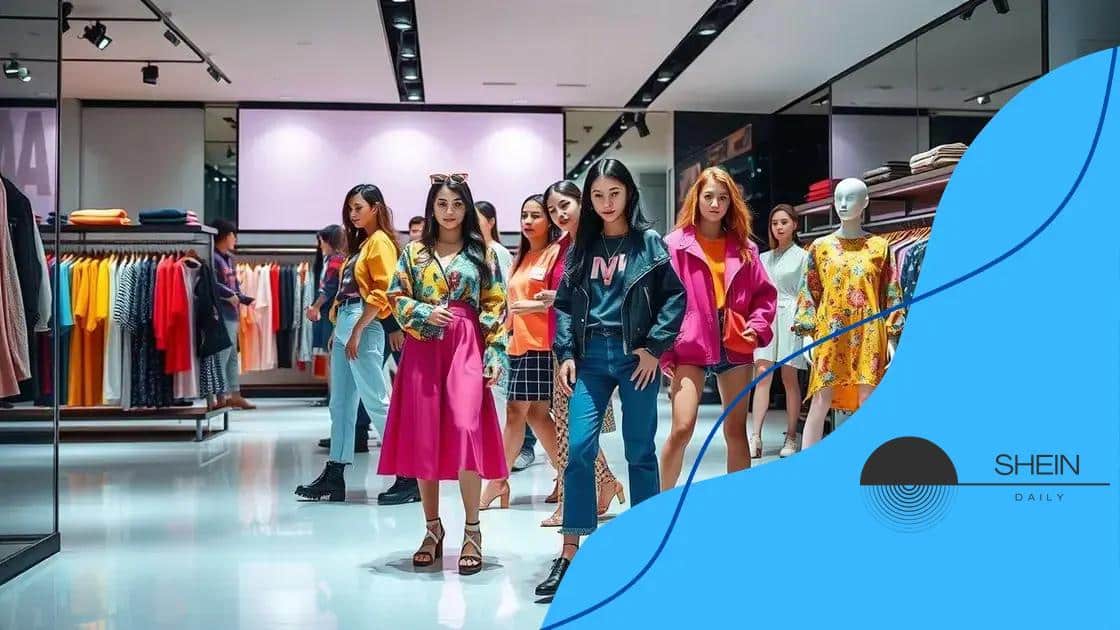Shein’s impact on global fashion market finances

Shein’s impact on global fashion market finances includes shifting consumer behavior towards affordable and trendy clothing, challenging traditional retailers, and emphasizing the need for sustainability and technological innovation in the industry.
Shein’s impact on global fashion market finances is a topic that’s turning heads in the industry. Have you noticed how this fast-fashion giant has altered buying patterns? Let’s explore its influence.
Understanding Shein’s business model
Understanding Shein’s business model is essential for grasping its impact on the global fashion landscape. This online retail giant has revolutionized how consumers shop for clothes.
At its core, Shein employs a fast fashion business model, which means it quickly turns around styles from the runway to retail. This speed allows Shein to stay ahead of trends and appeal to a young demographic eager for the latest looks.
Key Features of Shein’s Business Model
Several notable aspects define Shein’s approach:
- Data-Driven Design: Shein uses analytics to monitor fashion trends and consumer preferences. This data empowers them to create products that resonate with their target audience.
- Affordable Prices: By cutting out traditional retail overheads, Shein offers trendy clothing at lower prices than many competitors.
- Large Inventory: Their extensive inventory and frequent product launches keep the offerings fresh and exciting, encouraging customers to return often.
Additionally, Shein’s marketing strategies play a critical role. Collaborations with social media influencers boost their visibility and appeal to younger consumers. This digital-first approach, along with a targeted social media presence, accelerates their brand recognition.
Another important factor is Shein’s direct-to-consumer model, allowing the company to interact closely with customers. By receiving feedback directly, they can quickly adapt and respond to changing preferences.
Logistics and Supply Chain Efficiency
The efficiency of Shein’s logistics is impressive. By operating a highly automated supply chain, they minimize delays and maximize responsiveness to market demands. This nimbleness is crucial to their success.
In summary, Shein’s innovative business model captivates the fashion industry, merging technology, affordability, and speed to create a shopping experience that resonates with today’s consumers.
Financial implications on traditional retailers
The financial implications on traditional retailers due to Shein’s rise are significant and multifaceted. As consumers lean towards fast fashion for its affordability, many established brands face tough challenges.
Shein’s low-price offerings attract a customer base that once shopped at brick-and-mortar stores. This shift in consumer behavior pressures traditional retailers to rethink their pricing strategies and inventory management.
Impact on Sales and Revenue
One noticeable effect of Shein’s popularity is a decline in sales for many traditional retailers. As customers opt for cheaper options, established brands are seeing revenue losses:
- Revenue Decline: Many retailers report lower sales figures as shoppers turn to Shein for trendy, affordable clothing.
- Increased Discounts: To compete, traditional retailers often resort to deep discounts, eroding profit margins.
- Store Closures: The financial strain has led some retailers to close stores, impacting local economies.
This situation forces brands to innovate and adapt quickly. Many are shifting focus to enhance their online presence and invest in e-commerce solutions to meet changing consumer demands. By doing this, they can appeal to a tech-savvy audience that prefers online shopping.
Changing Operational Costs
In addition to sales impacts, Shein’s model alters the operational costs faced by traditional retailers. As these brands strive to improve supply chain efficiency, they encounter increased expenses in logistics and technology. Adopting new systems and streamlining operations require significant investment, which can be a daunting hurdle.
Ultimately, the financial landscape of the fashion industry is evolving due to Shein’s influence. Brands must now navigate this competitive environment while maintaining quality and brand loyalty, which becomes increasingly complicated in this fast-paced market.
Consumer behavior shift due to Shein

Consumer behavior shift due to Shein is reshaping the fashion landscape. As this fast-fashion retailer gains popularity, shopping habits are changing dramatically.
Today, customers are increasingly focused on value and trends. They seek affordable, stylish options that can be delivered quickly. This shift has led to a greater demand for brands that can offer similar fast-fashion solutions.
Desire for Trendy Options
One of the key changes is the consumer’s desire for trendy clothing. Shoppers, especially younger ones, prefer brands that can keep up with the latest fashion.
- Speed to Market: Consumers are drawn to brands that can provide new styles faster.
- Social Media Influence: Social media platforms showcase influencers wearing Shein’s latest pieces, driving demand.
- Online Shopping Preference: Many shoppers are opting to buy clothes online, making Shein an appealing option for convenience.
This shift does not just change where people shop, but also how they choose brands. Shoppers are less loyal to traditional retailers and more willing to try new brands that align with their values.
Value Over Brand Loyalty
Price is a significant factor in this change. Consumers often prioritize affordability over brand loyalty. A focus on getting the best deal motivates shoppers to switch brands quickly.
As a result, traditional retailers must adapt and rethink their strategies. Offering competitive prices and responding to customer feedback are vital for survival in today’s market. They need to engage consumers through effective marketing and enhance their online presence to stay relevant.
Overall, the influence of Shein is prompting profound changes in consumer behavior, making it essential for retailers to innovate continually.
Sustainability challenges in fast fashion
Sustainability challenges in fast fashion are becoming increasingly important as consumers gain awareness of environmental issues. Companies like Shein have faced scrutiny over their impact on the planet, prompting a discussion around sustainability.
The fast fashion model is designed for speed and low cost, but this can come at a high environmental price. For instance, the rapid production cycle often leads to the use of cheap materials that contribute to waste.
Environmental Impact
One significant challenge relates to the environmental repercussions of fast fashion:
- Water Usage: The industry consumes vast amounts of water, especially in cotton production, contributing to water shortages.
- Waste Generation: Fast fashion contributes to mountains of textile waste, with millions of tons ending up in landfills each year.
- Pollution: The dyes and chemicals used in clothing manufacturing can pollute water sources, affecting wildlife and communities.
As shoppers become more eco-conscious, they expect brands to adopt sustainable practices. This shift influences buying choices and could lead to higher demand for ethical and eco-friendly products.
Challenges for Brands
Many brands struggle to balance profitability with sustainability. Incorporating eco-friendly materials and sustainable practices can increase production costs, making it difficult to maintain low prices.
Additionally, ensuring supply chain transparency is crucial. Consumers want to know that their clothing is produced ethically. Brands must invest in tracking and reporting their sustainability efforts to build trust.
In summary, addressing sustainability challenges in fast fashion is essential for the industry’s future. As awareness grows, brands will need to adapt to consumer preferences for sustainable practices.
Future trends in the fashion industry
Future trends in the fashion industry are expected to reflect changing consumer behaviors and technological advancements. As the world evolves, so do the demands of shoppers.
One major trend is the rise of sustainability. Consumers are increasingly concerned about the environmental impact of their purchases. This focus on eco-friendly practices will likely push brands to adopt sustainable materials and ethical production processes.
Technological Innovations
Technology will also play a significant role in shaping the future of fashion:
- Virtual Shopping: The use of virtual reality and augmented reality will enhance online shopping by allowing customers to try on clothes virtually.
- 3D Printing: This technology offers the possibility of on-demand production, reducing waste and enabling customization.
- Supply Chain Transparency: Brands are expected to invest in technology that improves supply chain visibility, making it easier for consumers to know where their clothes come from.
In this rapidly changing landscape, brands must respond swiftly. Adapting to new trends requires agility, and companies that can innovate will likely succeed.
Changing Consumer Preferences
As consumers look for more personalized experiences, customization will become increasingly popular. Shoppers are seeking unique styles that reflect their individuality. Brands that offer tailored options will gain an edge.
Additionally, the growth of the second-hand market reflects a shift in consumer values. More people are choosing pre-owned items as a sustainable shopping option.
Ultimately, the fashion industry is on the cusp of significant change. By embracing sustainability, technological innovation, and consumer preferences, brands can navigate the future effectively.
FAQ – Frequently Asked Questions about Shein’s Impact on the Fashion Industry
How has Shein affected consumer shopping habits?
Shein has made affordability and trendiness a priority, causing many consumers to prioritize low prices and fast fashion options over brand loyalty.
What sustainability challenges does Shein face?
Shein faces challenges regarding water usage, waste generation, and pollution, all of which are significant issues in the fast fashion industry.
What future trends can we expect in the fashion industry?
Future trends include a greater focus on sustainability, technological innovations like augmented reality shopping, and a rise in personalized shopping experiences.
How are traditional retailers adapting to competition from Shein?
Many traditional retailers are improving their online presence, adjusting pricing strategies, and investing in sustainability to remain competitive.





